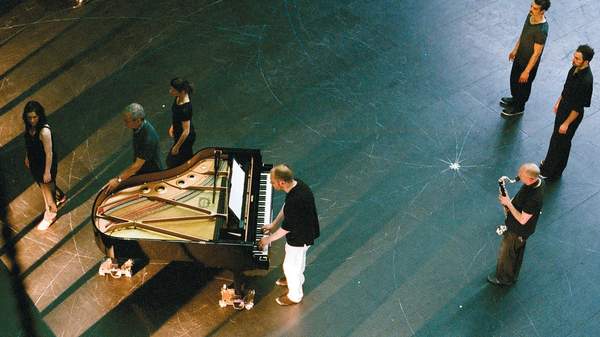Overview
There is something truly mesmerising about watching dance live. The way the performers twist and turn and push their bodies to the limits while making every move look effortless, the choreographers remarkable ability to convey emotion and story, and the way that costumes, lighting and music all come together to heighten a performance is nothing short of awe-inspiring. So then, why don't we go out and see more of it? According to the Live Performance Australia Ticket Attendance and Revenue Survey 2014, dance and ballet experienced a significant decrease in both gross revenue (16%) and attendance (21.3%) from 2013 to 2014. While there are certainly many issues at play here, those stats aren't great — and not at all reflective of the immense dance talent we have both locally and touring from overseas.
Thankfully, major arts festivals such as Sydney Festival continue to celebrate the dynamic art form. This coming festival is once again upping the ante with world-class art spanning countless genres and forms. It will bring over 700 exceptional artists and performers to Sydney — and with over 100 events in this year's program, so there's no shortage of something spectacular to see.
And coming all the way from Belgium is the contemporary dance company, Rosas. A magnificent highlight of this year's dance program, the company — led by choreographer and performer Anne Teresa De Keersmaeker — will be performing two works at the festival: Fase, Four Movements to the Music of Steve Reich and Vortex Temporum. Fase was first choreographed and performed in 1982 by De Keersmaeker, and will be performed by her again at 2016's Sydney Festival. The second performance, Vortex Temporum, is a collaboration between Rosas and music ensemble, Ictus.
But before we give too much away, here's a few things you need to know about De Keersmaeker and Rosas — and what you can expect them to bring to January's Sydney Festival.
DE KEERSMAEKER'S ROSAS
After deciding to focus on dance, music and theatre in her last year of high school, De Keersmaeker went on to study performing arts at the Mudra School in Brussels and NYU's Tisch School of the Arts. She then went on to create two works, Asch and Fase — which have since been performed by the company— before founding Rosas in 1983 during the creation of Rosas Danst Rosas.
One of the greatest things about Rosas' dance performances is that they manage to be both innovative and experimental without being intimidating or exclusive. De Keersmaeker does this through her selection in music, using contemporary musical sources rather than just sticking with the classics. For example, this year's debut performance of the dance company's Golden Hours (As you like it) incorporated both Shakespeare's comedy and Brian Eno's Another Green World.
The relationship between dance and music is one that is most frequently explored in Rosas choreography, as is her keen focus on naturally occurring repetition and patterns found in geometry, numerical patterns, and the natural world. This is a feature of Rosas Danst Rosas, one of her earliest works that has gone on to be highly influential. So influential in fact that De Keersmaeker accused Beyoncé of plagiarism in 2011 for the choreography of her video Countdown due to its similarities to Rosas Danst Rosas and other work Achterland. Well, if imitation is the sincerest form of flattery — and it's Queen Bey who's stealing your moves — you're clearly doing something very right.
FASE, FOUR MOVEMENTS TO THE MUSIC OF STEVE REICH
Considered a seminal piece in the evolution of contemporary dance, Fase has been engrossing audiences for over 30 years. As the name suggests, the performance is broken down into four sections: three duets and one solo. Each section — Piano Phase, Come Out, Violin Phase and Clapping Music — is set to a different minimalist piece by American composer, Steve Reich, and is matched so perfectly to the choreography that movement and sound combine with mechanical precision.
Fase's strength lies in its embodiment of contrasts — from delicacy to chaos and back again. To this day, Anne Teresa De Keersmaeker still performs this piece all over the world. Imagine creating something so profound so early in your career, and still performing it decades later? It's no wonder that this is perhaps De Keersmaeker's most performed piece.
Fase will be performed at the Sydney Opera House with Rosas dancer Tale Dolven over three nights from January 9-11. You can buy tickets here.
VORTEX TEMPORUM
Created in 2013, Vortex Temporum explores Gérard Grisey's musical masterpiece in a way that combines dance and instrumentation on a whole new level. Seven dancers and six musicians take the stage, and proceed to entwine, as a designated dancer and their movements represent each instrument's sound. Both dancers and musicians move through the space as a vortex — even the piano is on wheels.
The contemporary music ensemble Ictus have collaborated with Rosas in previous works Drumming (1998) and Rain (2001). The performance unfolds slowly as dancer and musician become more tangled. It really is quite a sight to behold.
Vortex Temporum will be performed at Carriageworks over four nights from January 15-18. You can buy tickets here.
For more information on performances and to view the full program, visit the Sydney Festival website.
